Critical role of spectrin in hearing development and deafness
- PMID: 31001589
- PMCID: PMC6469942
- DOI: 10.1126/sciadv.aav7803
Critical role of spectrin in hearing development and deafness
Abstract
Inner ear hair cells (HCs) detect sound through the deflection of mechanosensory stereocilia. Stereocilia are inserted into the cuticular plate of HCs by parallel actin rootlets, where they convert sound-induced mechanical vibrations into electrical signals. The molecules that support these rootlets and enable them to withstand constant mechanical stresses underpin our ability to hear. However, the structures of these molecules have remained unknown. We hypothesized that αII- and βII-spectrin subunits fulfill this role, and investigated their structural organization in rodent HCs. Using super-resolution fluorescence imaging, we found that spectrin formed ring-like structures around the base of stereocilia rootlets. These spectrin rings were associated with the hearing ability of mice. Further, HC-specific, βII-spectrin knockout mice displayed profound deafness. Overall, our work has identified and characterized structures of spectrin that play a crucial role in mammalian hearing development.
Figures
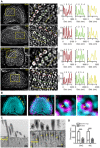
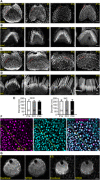
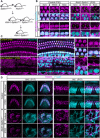
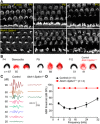
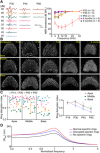
Similar articles
-
Essential Role of Sptan1 in Cochlear Hair Cell Morphology and Function Via Focal Adhesion Signaling.Mol Neurobiol. 2022 Jan;59(1):386-404. doi: 10.1007/s12035-021-02551-2. Epub 2021 Oct 27. Mol Neurobiol. 2022. PMID: 34708331 Free PMC article.
-
TRIOBP-5 sculpts stereocilia rootlets and stiffens supporting cells enabling hearing.JCI Insight. 2019 Jun 20;4(12):e128561. doi: 10.1172/jci.insight.128561. eCollection 2019 Jun 20. JCI Insight. 2019. PMID: 31217345 Free PMC article.
-
Actin-bundling protein TRIOBP forms resilient rootlets of hair cell stereocilia essential for hearing.Cell. 2010 May 28;141(5):786-98. doi: 10.1016/j.cell.2010.03.049. Cell. 2010. PMID: 20510926 Free PMC article.
-
Hair cells, plasma membrane Ca²⁺ ATPase and deafness.Int J Biochem Cell Biol. 2012 May;44(5):679-83. doi: 10.1016/j.biocel.2012.02.006. Epub 2012 Feb 13. Int J Biochem Cell Biol. 2012. PMID: 22349217 Review.
-
The plasma membrane calcium pump in the hearing process: physiology and pathology.Sci China Life Sci. 2011 Aug;54(8):686-90. doi: 10.1007/s11427-011-4200-z. Epub 2011 Jul 24. Sci China Life Sci. 2011. PMID: 21786191 Review.
Cited by
-
The Rho GTPase Cell Division Cycle 42 Regulates Stereocilia Development in Cochlear Hair Cells.Front Cell Dev Biol. 2021 Oct 22;9:765559. doi: 10.3389/fcell.2021.765559. eCollection 2021. Front Cell Dev Biol. 2021. PMID: 34746154 Free PMC article.
-
Recent development of AAV-based gene therapies for inner ear disorders.Gene Ther. 2020 Aug;27(7-8):329-337. doi: 10.1038/s41434-020-0155-7. Epub 2020 May 18. Gene Ther. 2020. PMID: 32424232 Free PMC article. Review.
-
PIN1 Protects Hair Cells and Auditory HEI-OC1 Cells against Senescence by Inhibiting the PI3K/Akt/mTOR Pathway.Oxid Med Cell Longev. 2021 Jun 2;2021:9980444. doi: 10.1155/2021/9980444. eCollection 2021. Oxid Med Cell Longev. 2021. PMID: 34285767 Free PMC article.
-
βII spectrin (SPTBN1): biological function and clinical potential in cancer and other diseases.Int J Biol Sci. 2021 Jan 1;17(1):32-49. doi: 10.7150/ijbs.52375. eCollection 2021. Int J Biol Sci. 2021. PMID: 33390831 Free PMC article. Review.
-
Atrial Natriuretic Peptide Improves Neurite Outgrowth from Spiral Ganglion Neurons In Vitro through a cGMP-Dependent Manner.Neural Plast. 2020 Aug 28;2020:8831735. doi: 10.1155/2020/8831735. eCollection 2020. Neural Plast. 2020. PMID: 33193754 Free PMC article.
References
-
- Tilney L. G., Egelman E. H., DeRosier D. J., Saunder J. C., Actin filaments, stereocilia, and hair cells of the bird cochlea. II. Packing of actin filaments in the stereocilia and in the cuticular plate and what happens to the organization when the stereocilia are bent. J. Cell Biol. 96, 822–834 (1983). - PMC - PubMed
-
- Tilney L. G., DeRosier D. J., Actin filaments, stereocilia, and hair cells of the bird cochlea: IV. How the actin filaments become organized in developing stereocilia and in the cuticular plate. Dev. Biol. 116, 119–129 (1986). - PubMed
Publication types
MeSH terms
Substances
LinkOut - more resources
Full Text Sources
Other Literature Sources
Medical
Molecular Biology Databases

